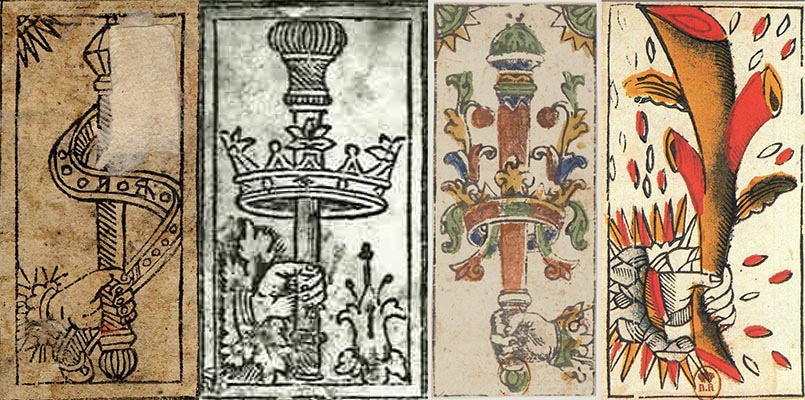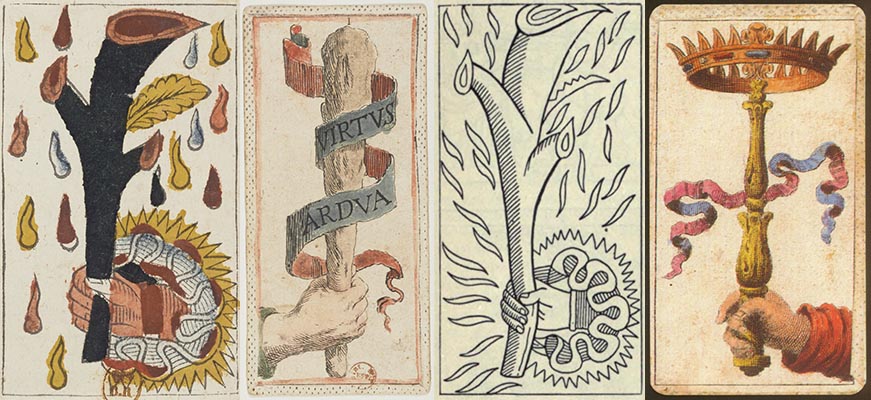THE TAROT WHEEL
THE SUIT OF BATONS
The suit of batons is a bit strange regarding the other suit symbol. Coins, Cups and Swords are easy to explain and existed also on the Mamlûk cards. Batons are different. On the Mamlûk cards we see polo sticks, on the hand-painted cards we see different symbols and on the later decks they changed again. Let us look at some Aces, while this is the numbered card, that should represent the best the characteristics of this suit symbol.
In the image here above, we see four hand-painted Aces of batons from 15th Century Italy. From left to right the Visconti di Modrone or Cary Yale Visconti (Milano, 1442), the Brera-Brambilla Visconti (Milano, 1445-1447), the Visconti-Sforza (Milano, 1451-1454) and the Sola Busca (Ferrara or Florence,1491). We see four different objects, an arrow, some sort of lance, a kind of scepter and a club, the first three are man-made, and the last one is a wooden object.
On the next series of images from left to right an Ace from one of the Budapest sheets (Italy, Firenze or Bologna, early 16th Century), the Rosenwald sheet (Italy, Firenze or Bologna, early 16th Century), the Tarocchi da Bologna (Italy, Bologna, +1600) and the Tarot of Jaques Vievil (France, Paris, mid 17th Century). We remark that the first three cards are very similar and illustrate a royal scepter. The last one is a branch of a tree with still some leaves on it. All four Batons are held in the air by a hand, a left hand for most of them, a right hand for the Tarocchi da Bologna.
On the last series from left to right the Tarot of Jean Noblet (France, Paris, mid 17th Century), the Tarocchino of Giuseppe Mitelli (Italy, Bologna, mid 17th Century), the Tarot of Nicolas Rolichon (France, Lyon, last quarter of the 17th Century) and a Minchiate de Firenze (Italy, Firenze, first quarter 18th Century). All the Batons are held by a right hand, although this hand is drawn from the back (and thus coming from the left) on the Tarocchini card. The first and the third image are members of the Tarot of Marseille family, they are very similar to the Vievil Tarot, although mirrored relative to the older deck. On the Tarocchino deck a club, and on the Minchate deck again a royal scepter, the image seems closely related to the Tarocchi da Bologna.
What can we deduct from these images? There are regional and time related differences. In the 15th Century, the symbol was different from deck to deck. On the Italian decks a scepter or sometimes a club was shown, while the French decks show a living branch. Starting the early 16th Century on all decks the suit symbol is upright in the air in someone's hand, a symbol of force and power; resembling a phallus. An evidently active and male symbol. In the early French decks, shown above, the Ace of Batons clearly symbolize the energy of life, the reproductive force. In the Italian decks, the royal scepter or the strong club is a phallus symbol indicating the same reproductive energy and force.
Traditionally Batons are associated with pure energy, with the element Fire. From the above deduction, we conclude that the element Fire by itself is a symbol for the energy of live, the force of reproduction. So, Batons are associated with reproductive energy. In a general way, Batons are dealing with sexual desire, the state of mind that can make you act without thinking. Your mind is not governed by logic reasoning like in the suit of Swords, with emotions like in the suit of Cups or with egoism and self-protection like in the suit of Coins, no, it is only governed by pure desire. For this reason, our reproductive organs are the parts of our body that are associated with the Batons. Our sexual desire is a basic instinct that guarantees the survival of our kind. So, Batons are dealing with our society and with human mankind, that is expressed in the plural of the first person, in We. If many Batons turn up in a particular reading, the spread is dealing with things of general interest of us all. In a more restrictive way, batons can deal with our race, our ethic group or our home country. The Virtue linked closest to the suit of Batons is Strength, the moral force that enables us to resist to this desire.





